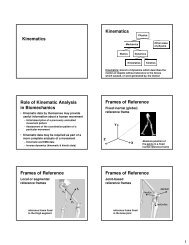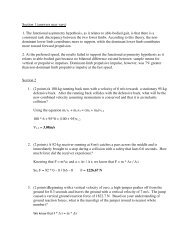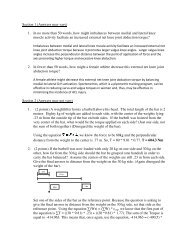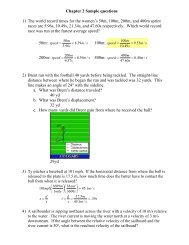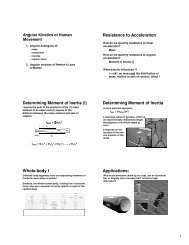Kinesiological Electromyography (EMG) Electromyography ...
Kinesiological Electromyography (EMG) Electromyography ...
Kinesiological Electromyography (EMG) Electromyography ...
Create successful ePaper yourself
Turn your PDF publications into a flip-book with our unique Google optimized e-Paper software.
Recording the <strong>EMG</strong><br />
Signal is dependent on:<br />
– Amount and type of interspersed tissue<br />
– Electrode size<br />
– Electrode spacing<br />
– Electrode position over the muscle<br />
– Amplifier characteristics<br />
Recording the <strong>EMG</strong><br />
Electrode placement - should be between innervation<br />
zone and distal tendon, or between two innervation<br />
zones; long axis of electrode should be parallel to<br />
muscle fibers<br />
Noise arises from<br />
– Other biosignals (e.g., ECG)<br />
– Power line hum<br />
– Electrode movement<br />
– Cabling artifact<br />
– Amplifier<br />
Recording the <strong>EMG</strong><br />
Electrode placement<br />
– Do not place electrode near myotendonous<br />
junction<br />
– Do not place electrode at innervation zone (motor<br />
point), although this was a commonly<br />
recommended location for electrode placement<br />
for many years<br />
– Approximate innervation zone locations and fiber<br />
orientations can be obtained from anatomy<br />
atlases<br />
– In the absence of better information, place the<br />
electrode just distal to mid-point of muscle belly<br />
– http://seniam.org/<br />
Recording the <strong>EMG</strong><br />
Effect of electrode placement on signal characteristics<br />
Recording the <strong>EMG</strong><br />
Amplifier Considerations<br />
• <strong>EMG</strong> amps come in two configurations<br />
– Single-ended<br />
– Differential<br />
• Major amplifier characteristics that affect<br />
signal quality are:<br />
– System gain<br />
– Input impedance<br />
– Frequency response<br />
– Common-mode rejection<br />
Recording the <strong>EMG</strong><br />
Single-ended amplifier (monopolar): recorded <strong>EMG</strong><br />
voltage at electrode is referenced to a distant ground<br />
electrode<br />
Differential amplifier (bipolar): recorded <strong>EMG</strong> voltage is<br />
difference between signal on two electrodes after<br />
comparison with reference ground electrode<br />
4




